Lord Northbourne's Funeral Pall and chest, c. 1913
/Lord Northbourne's Funeral Pall and chest c.1913
September 21, 1991
Presented by Lord Northbourne in 1913 in memory of Dean Ernald Lane, the brother of Lady Northbourne, the Northbourne Funeral Pall is the finest of its type in the Cathedral collections. It was recently used during the period of national mourning for Queen Elizabeth II.
Ernald Lane, Dean of Rochester 1904-1913, is commemorated by plaque in the south east transept of the cathedral and by a magnificent funeral pall, an important example of early twentieth century embroidery donated by Lord Northbourne and his wife who was the sister of the dean.
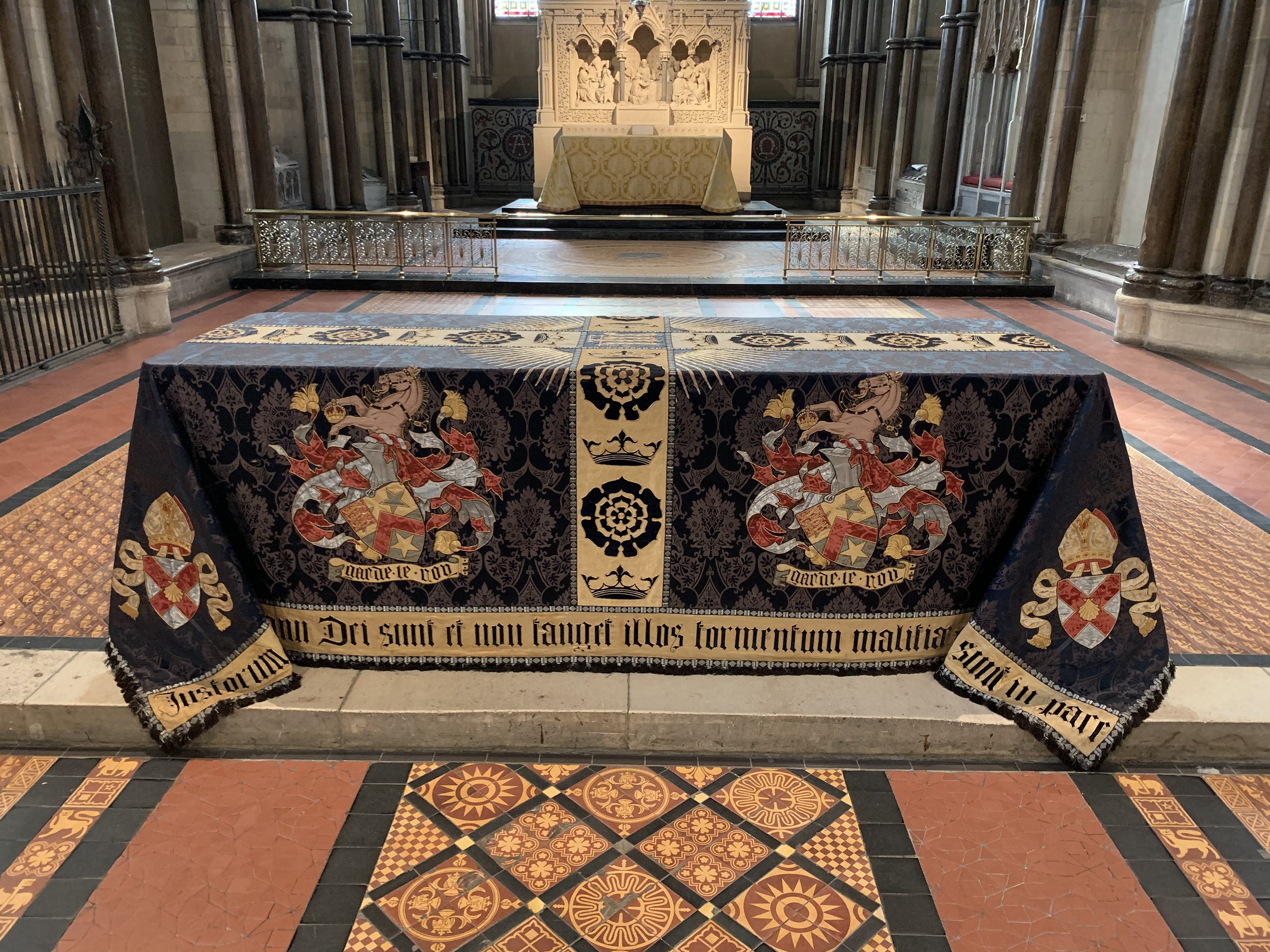
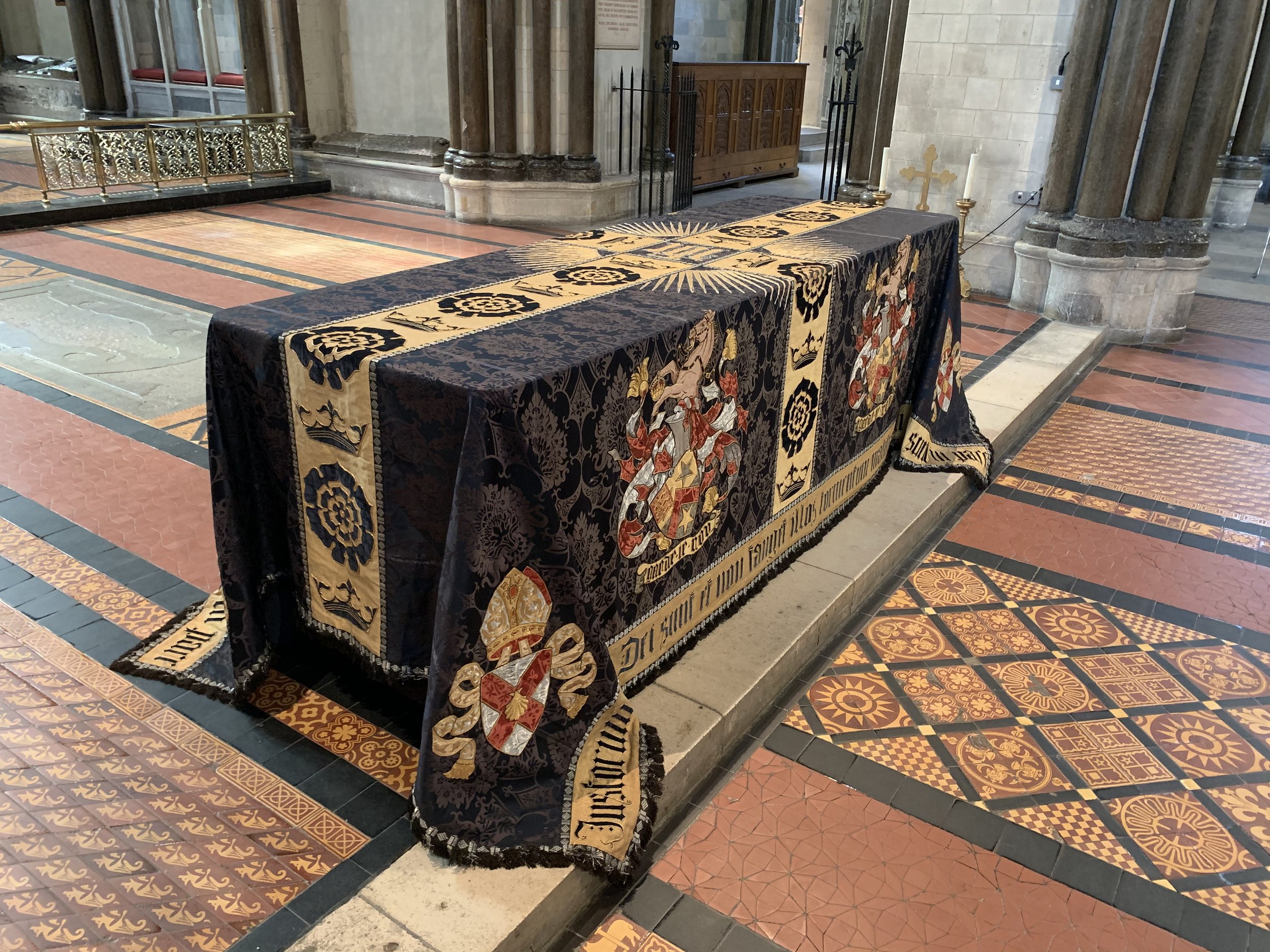
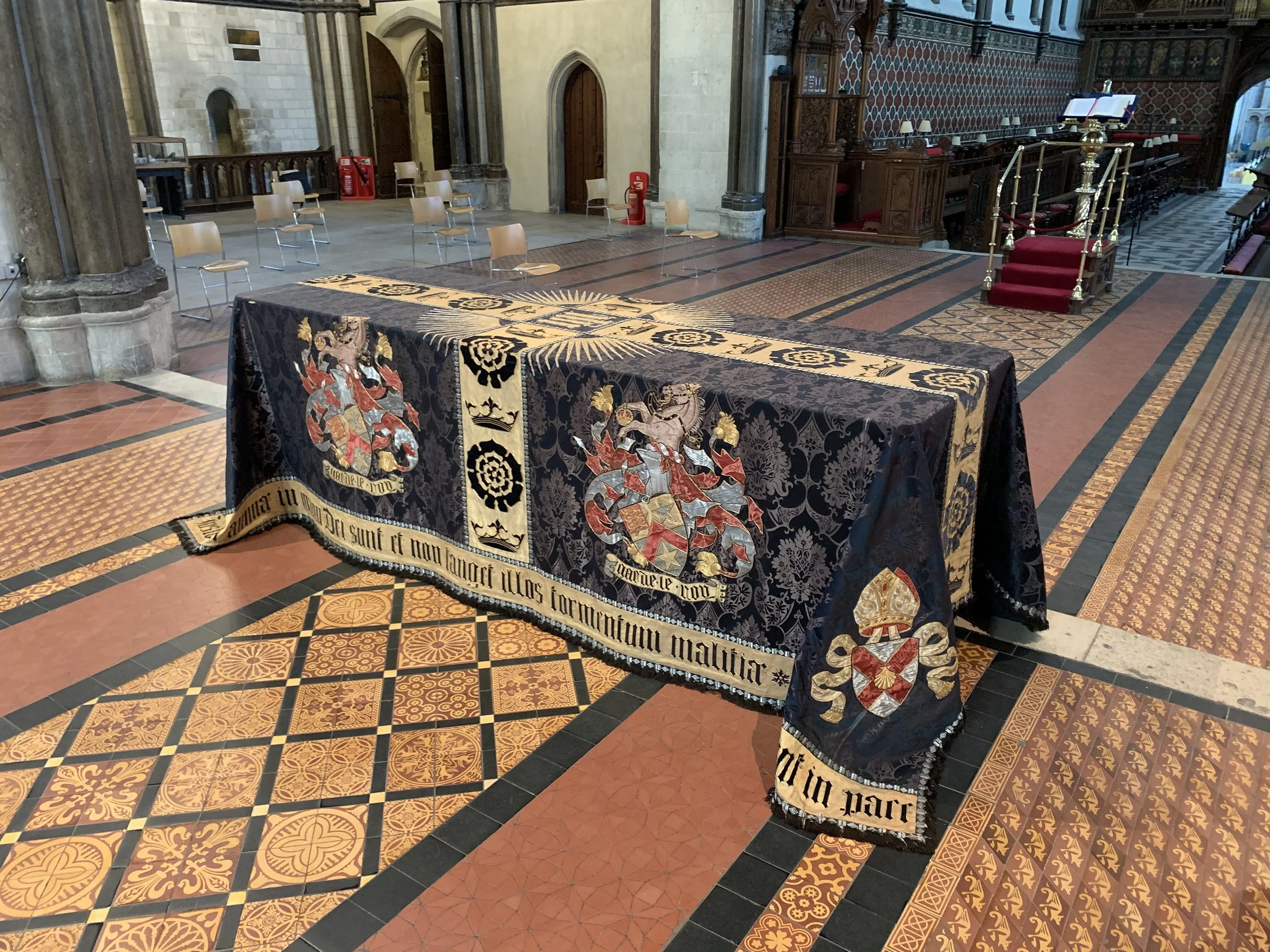
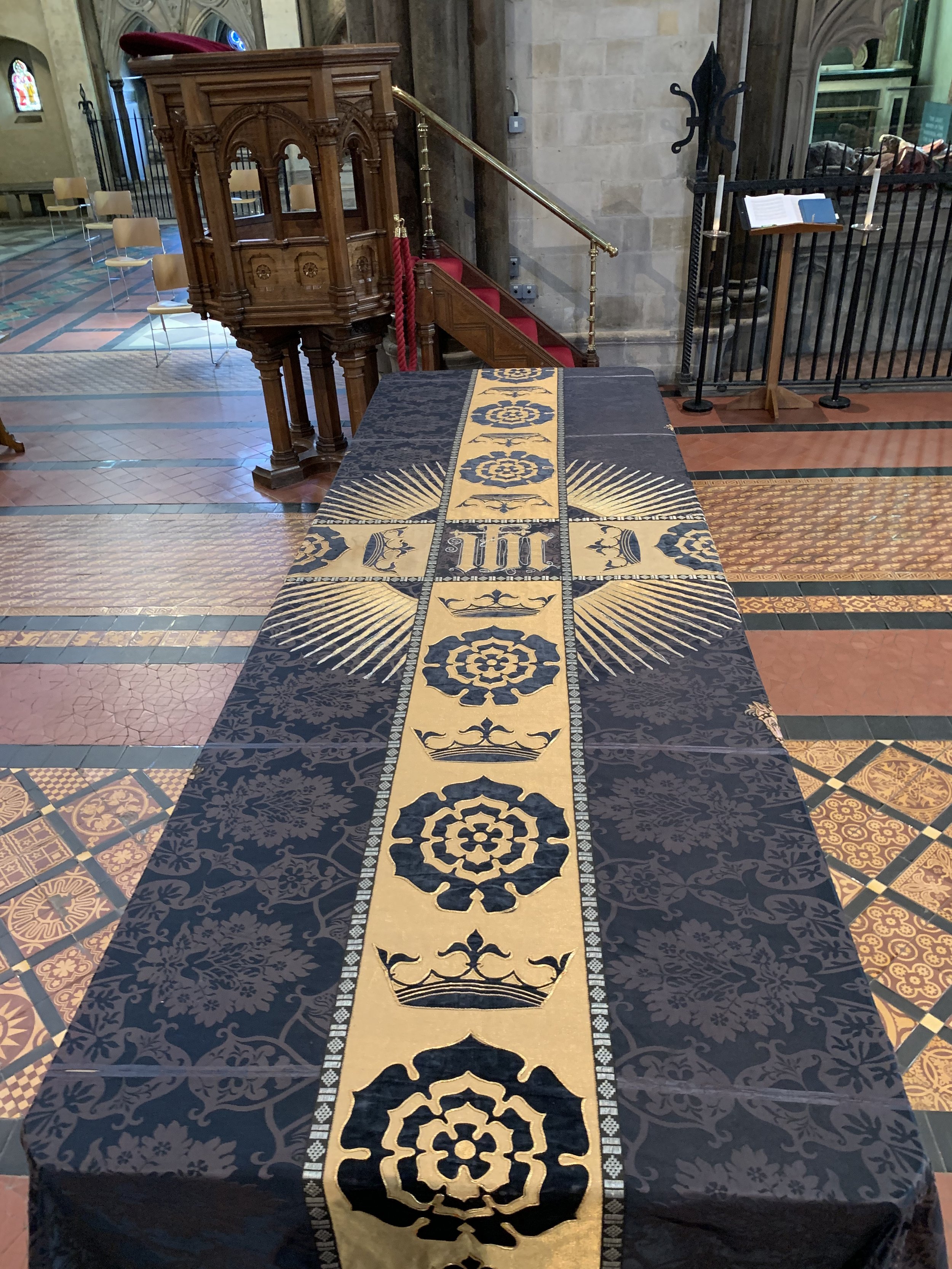
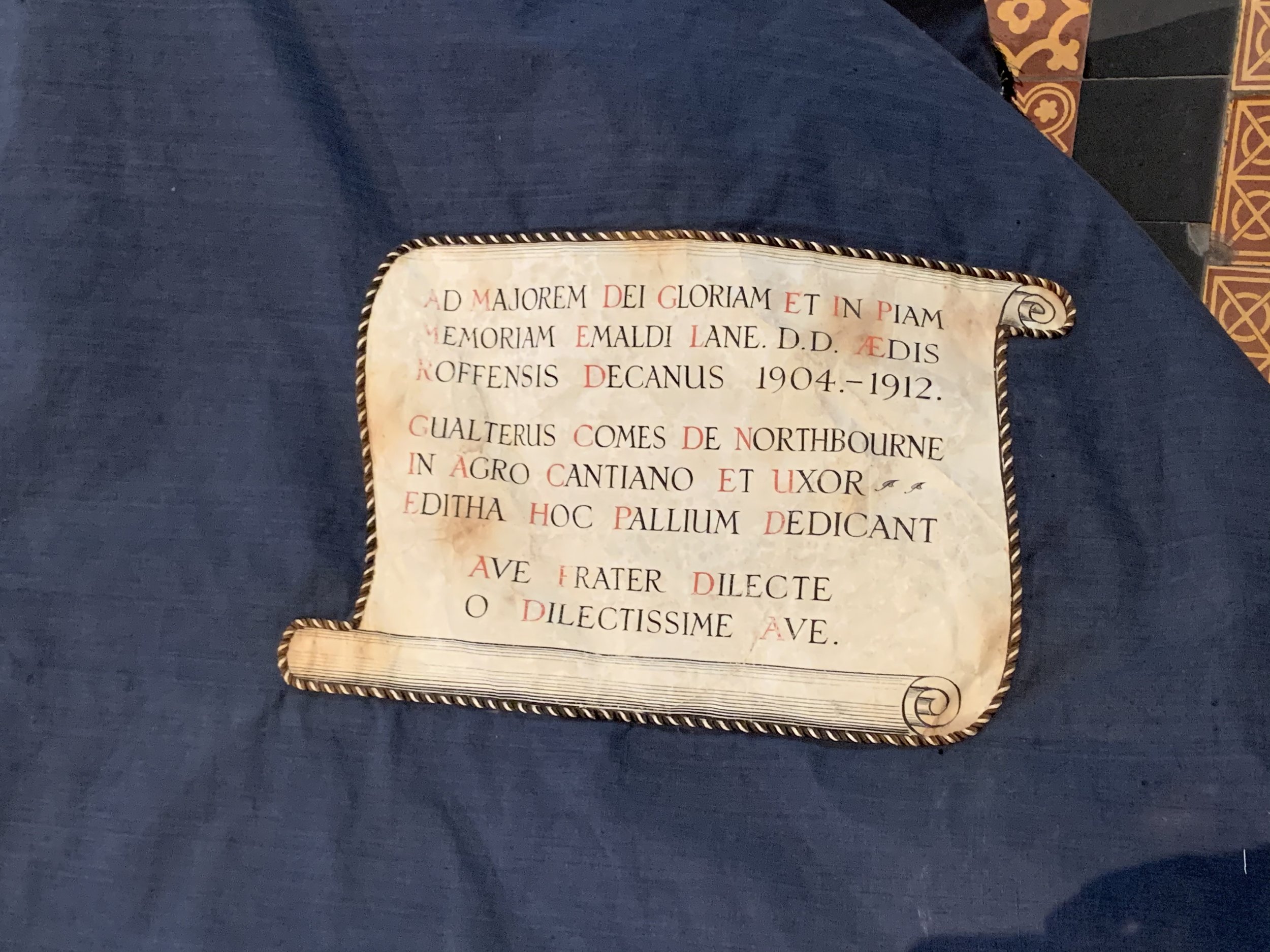
Photos of the Northbourne Pall in 2022.
The arms which decorate the pall are those of the diocese of Rochester and the Lane family. John Lane, of Bentley, Staffordshire, married Margaret, daughter of heir of Thomas Partich, of King’s Bromley in the same county, he died in 1578. Their son, Thomas, married Catherine, daughter of Richard Treetham of Rochester and one of their children was also Thomas, a loyal royalist. This Thomas snd ___ of his chikdren, John and Jane, assisted in the preservation of King Charles II after the battle of Worcester.
After the Commonwealth was established in England Charles made a desperate effort to regain the crown which culminated in his disastrous defeat at Worcester in 1651. With the help of colonel Carlos the King escaped from the city and hid in an oak tree at Boscobel before he sought refuge in the home of colonel John Lane at Bentley. From there he fled on horseback with mistress lane disguised as her servant. They travelled to Abbot's Leigh, near Bristol, and thence to Somerset from where the King sailed to the continent and safety.
When King Charles was restored to the throne the Lanes were granted two remarkable additions to their family arms. First, the arms of England - 'three lions passant guardant, on a canton given in augmentation'. Augmentations indicate deeds which the souvereign considers worthy of being held in especial remembrance and although other families, particularly in the eighteenth and nineteenth centuries, have been honoured - for example with one lion passant or a royal crown - the Lanes are the only family to whom the arms of England has been given. A most curious result of this happened when the use of armorial bearings were taxed by an act of parliament, the royal arms were exempted and on account of this canton the Lane family claimed and obtained exemption from the tax. Secondly, a few years later, a crest was granted - 'a strawberry roan horse supporting between its feet the imperial crown'. It was upon a horse of this colour that the King and mistress Jane escaped.
John Newton Lane was born at King's Bromley in 1800 and married the Hon. Agnes Bagot who was descended from a family who were living in Staffordshire at the time of the Domesday survey. They had ten children of whom the seventh was Ernald, born in 1836.
He was educated at Balliol College, Oxford and was a Fellow of All Souls', Oxford from 1860-79. In 1866 he became rector of Albury, Oxfordshire for two years and then vicar of St. Michael's, Handsworth, Birmingham. Lane was instituted archdeacon of Stoke-on-Trent (1888-1901), vice-provost of St. Mary and St. John Lichfield (1898-1904) and rector of Leigh, Staffordshire (1871-1904). He was married. Ernald was Dean of Rochester from 1904 unti his death in 1913. He is buried at King's Bromley.
Edith Emmeline Mary Lane, sister of Ernald, married Walter Henry James, 2nd baron Northbourne, who at one time was member of Parliament for Gateshead and a justice of the peace in Kent. A dedication, written in Latin on vellum and sewn to the lining of the pall translates,
Walter, a friend from Northbourne and his wife Edith dedicate this pall.
The fervour which inspired the builders of our great gothic cathedrals influenced the embroiderers of furnishings and vestments. Fragments of needlework from St. Cuthbert's tomb at Durham, worked between 905-916, and other pieces believed to have been worn by bishop Walter de Cantelupe (1233-66) at Worcester foreshadowed the great period of Opus Anglicanum (1250-1350) when English embroidery was famed throughout Europe. During the latter part of the fourteenth century rich silk materials became more available - velvets, brocades and damasks - which required new techniques from embroidery. A method was developed in which motifs were worked on a linen ground and when complete were attached to the silk. This is known as appliqué and the various embroideries on this pall have been applied to the blue/black silk damask, using cloth of gold and cloth of silver extensively.
Many of the beautiful and elaborate City Company palls belong to the period from the mid fifteenth to mid sixteenth centuries and influenced later work, a superb example made for the worshipful Company of Saddlers may be seen at the Victoria and Albert Museum, South Kensington. All palls are of a similar size and very large, about thirteen feet in length, with much use made of the decorative values of heraldry and lettering.
Heraldry has constantly been combined with decoration for the church, the arms of donors or associated families frequently appears and are sometimes the only clue to authorship. Heraldic art has a beauty and simplicity suited to the dignity of church ceremonial but the designer has to understand this type of ornament and treat it boldly with an appropriate choice of scale, materials and colour. For these reasons the services of a suitably qualified architect were often sought.
During the early years of the nineteenth century the standard of design on church furnishings was very poor. One of the first architects to concern himself with this problem was Augustus Pusin (1812-1852), and in 1844 he published the Glossary of Ecclesiastical Ornament in which he set out his principles of good decoration with an appropriate meaning. Many of his designs conformed to the plan of a large cross with a suitable symbol at the interchange which has been used for the centre of this pall; the cross formed from cream silk with appliqued black velvet crowns and roses, which symbolise sovereignity and the Virgin Mary, with IHS at the interchange.
In 1854 the Ladies' Ecclesiastical Society was founded, the first of many similar groups which undertook the training of embroideresses to produce church needlework, most of the ladies gave their time and labour gratuitously and worked under the supervision of a competent architect. Several leading architects are known to have turned their attention to such projects, and worked for firms of church furnishers including Watts and Company who may have made this pall. Among these men were George Bodley (1827-1907); W. Curtis Brangwyn; E. W. Godwin; I. D. Sedding, diocesan architect of Bath and Wells and the Reverend Selwyn Image (1849-1930), who designed for the Royal School of (Art) Needlework and must have known W. G. Paulson Townshend who was design master there and included a chapter on ecclesiastical and heraldic needlework in his book Embroidery of the Craft of the Needle (1907). However, it must be noted that at the time the Northbourne Pall was made, many designers would have chosen the fashionable Art Needlework and not a formal heraldic decoration.
As a means of communication embroidered lettering has been, and still is, important; whether to convey a message from the scriptures or record a date, name or place. In the latter part of the nineteenth century the style of lettering deteriorated and would not improve until the 1950s, variants of bastard Lombardic scripts were invented and such pseudo-gothic letters were used for the Latin inscription around the foot of this pall:
Justorum animae in manu Dei sunt, et non tanget illos tormentum malitiae: illi autem sunt in pace.
This is an adaptation of the first and third verses of Wisdom chapter III and translates:
The souls of the righteous are in the hand of God, and there shall no torment touch them; but they are in peace.
For some years the Northbourne Pall was used as an altar frontal in the Jesus Chapel and suffered considerable wear. Recently, it has been restored by Mrs. Marion Kite of the conservation department, Victoria and Albert Museum, who suggested that as the cloth of gold and cloth of silver were fragile the pall should be kept behind glass. However, due to the cost and the lack of a suitable site this is not possible and it is stored in its own wooden case. The case featuring fine ornamental ironwork was designed by Temple Moore and made J. Thompson & Co Peterborough. The ironwork was produced by F. Coldron & Son, Brant Broughton, 1814-16.
Ernald Lane was a person of wide sympathies, a lover of country life and an antiquary. He was a man of prayer and deeply concerned for order and decency in the cathedral. To quote once more from the dedication by Lord Northbourne and his wife:
Ave frate dilecte O delectissime ave
Farewell O beloved brother most beloved farewell.
Molly G. Proctor
References
Burke's Landed Gentry vol I.
Burke's Peerage.
Day Lewis, F., Art in Needlework, 1901.
Dean, Beryl, Ecclesiastical Embroidery, 1958.
Fox-Davies, A. C., Complete Guide to Heraldry, 1909. Armorial Families, 1901,
Morris, Barbara, Victorian Embroidery, 1962
Welsby, The Revd. Dr. Canon P. A., Notes on Ernald Lane.
The Friends of Rochester Cathedral were founded to help finance the maintenance of the fabric and grounds. The Friends’ annual reports have become a trove of articles on the fabric and history of the cathedral.
The Guild of Embroiderers are proud to care for over 100 ecclesiastical vestments and textile treasures.





